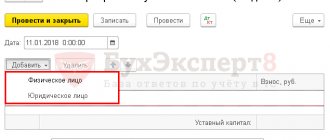How are net assets related to the company's capital?
Net assets are formed by current assets, which were purchased using own funds or using long-term loans.
With positive dynamics of this indicator over the last reporting periods:
- the company is attractive to investors;
- There is an advantage when applying for loans from banking institutions.
This indicates a high level of solvency and reliability of the enterprise’s financial system.
Low growth rates of working capital - the ratio of net assets and authorized capital with a clear predominance of the latter indicator - signals about the ineffectiveness of the financial strategy. This symptomatology is typical for enterprises in crisis. A negative net asset value means that the solvency of the company and the level of confidence in the company on the part of potential investors are critically low.
Also see “Negative Net Assets: Implications.”
When analyzing operating results, it is necessary to adhere to the rule that net assets must be greater than the authorized capital. Violation of this balance may be a consequence of attracting a large volume of short-term loans.
There are two ways to correct the situation:
- An increase in the value of assets.
- Reducing the amount of capital.
The law does not provide for penalties for violating the optimal balance between assets and the sources of their formation. But still, net assets and authorized capital must be regularly compared in order to promptly identify negative trends.
The manager is interested in quickly eliminating shortcomings in the financial sector in order to avoid undesirable consequences:
- decreased solvency;
- difficulties in attracting new investors;
- refusals of banking structures to provide loans on standard or preferential terms;
- lack of trust on the part of counterparties;
- increasing the risk of forced liquidation by regulatory government agencies.
The last option is possible if net assets are below the authorized capital over the last 2 years. The closure of a business will also be inevitable if it is impossible to revaluate assets or reduce the amount of capital.
Managers and founders must organize internal management accounting to identify negative trends in the enterprise’s economy. Significant assistance can be obtained from auditors who record in their report:
- change in the value of net assets and authorized capital, the ratio of these indicators;
- recommendations for leading a company out of crisis.
Net assets value. How Negative Net Assets Affect Financial Statements
The net assets of an organization are considered to be the company's own funds.
These are the assets that remain at the disposal of the company when it fully pays off its obligations to creditors. In general, they can be represented as the difference between the assets and liabilities of the company. In practice, accountants use a special formula to calculate this indicator.
The data is taken from the balance sheet as of the reporting date.
The value of net assets - what is it, how to calculate it yourself?
The procedure for calculating the value of net assets was approved by the Ministry of Finance in document No. 84n dated August 28, 2014. The calculation is based on balance sheet indicators.
In a simplified form, the calculation formula can be presented as follows:
Net assets of the company as of a specific date = Total for Section III + Amount of deferred income – Debt of company participants for contributions to the authorized capital
It turns out that, in fact, the value of net assets corresponds to the size of the company's equity capital. How then should we evaluate the fact that net assets can also have a negative value?
Why might a firm's net assets become negative?
Let's look again at the formula for calculating net assets. The main significance in it is the result of the third section of the balance sheet. In fact, this is the sum of the values for the lines “Authorized capital” and “Retained earnings (uncovered loss)”.
It turns out that if the company suffered a significant loss at one time or systematically operates at a loss and its value exceeds the amount of the authorized capital adjusted for unpaid contributions of participants, then the company will end the reporting period with a negative net asset value.
Of course, their size may be affected by deferred income (income of future periods), but as a rule, their value in companies is not large.
Let's look at specific cases where net assets can become negative.
What facts of economic activity lead to a negative net asset value?
For example, the company had a lengthy trial, which was ultimately resolved not in our favor. The following entry will appear on the balance sheet:
Debit account 91.02 “Other expenses” Credit account 76.05 “Settlements with other creditors”
Such an entry must be made at the time the court decision enters into force.
If the profit at the end of this reporting period was 200 thousand rubles, and the amount recovered as part of the trial is 1,000 thousand rubles, then a loss at the end of the period in the amount of 800 thousand rubles is inevitable. And if the authorized capital is insignificant and equal to 10,000 rubles, then the company’s net assets will become negative.
However, it is possible to gradually accumulate losses from ordinary activities, which in one of the reporting periods will make the value of net assets negative.
In addition, we should not forget that the company’s debtors (debtors) can significantly worsen the financial reporting indicators. According to the requirements of the Ministry of Finance, companies are required to create reserves for doubtful debts, which directly affect the amount of profit, and, therefore, indirectly participate in the calculation of the enterprise’s net assets.
For example, the debtor never paid the 3,000 thousand rubles due under the completed contract. The debt as of the reporting date is more than 90 days. The company is obliged to accrue a reserve for doubtful debts for the entire amount of the debtor's debt by posting:
Debit account 91.02 “Other expenses” Credit account 63 “Provisions for doubtful debts”
If for some reason you have not created a reserve, and the debt has been on your balance sheet for more than 3 years, it must be written off using the following entry:
Debit account 91.02 “Other expenses” Credit account 62 “Accounts receivable” and for 5 years take into account written-off receivables, but already off the balance sheet.
It turns out that the inventory of receivables and payables, which is performed before drawing up the annual report, may require the creation of reserves, which will ultimately lead your net assets to a negative value.
What can result from reflecting negative net assets on the balance sheet?
A company must be liquidated if its net assets are negative for 2 years in a row.
As you can see, the consequences can be very serious. Moreover, it is not the company's choice or right. In fact, it no longer depends on her whether she will decide on liquidation or not. The company will be forcibly liquidated. All companies report net asset value as part of their annual financial statements.
Joint-stock companies are required to record their value on the Fedresurs.ru website in the public domain. The liquidation will be carried out by the tax authorities on the basis of the relevant Federal Law No. 934-I of March 21, 1991. The very form in which the company is organized does not play a role in this case.
The procedure will be initiated by the control agency in court.
Source: https://ce-na.ru/news/otritsatelnye-chistye-aktivy-vliyanie-na-finansovuyu-otchetnost/
Ways to solve the problem
There may be several options for eliminating the imbalance in the financial sector of a company:
| 1 | Revaluation of enterprise assets | The procedure is carried out in order to increase the value of working capital |
| 2 | Additional cash contribution from the founder | This method can also be used in situations where net assets are equal to equity. In the payment order, in the payment purpose field, you must indicate that the money is intended specifically to increase the value of assets. |
| 3 | Initiating a reduction in the size of the formed and redeemed authorized capital | – |
The option of additional cash injections is possible provided that the founder agrees to invest his own funds to improve the financial stability of the company. And the revaluation method will help to quickly increase the amount of working capital, although it has many costs: net assets will be greater than the authorized capital, but the procedure for changing the estimated value will have to be repeated regularly.
The amount of capital can be reduced if the current value of its valuation is above the minimum threshold.
If the imbalance persists for a long time and the capital amount is minimal, the tax authorities may raise the issue of liquidating the enterprise. The decision is made in court.
The court will decide in favor of the company if, at the time of consideration of the case, the net assets exceed the authorized capital or the business owners are able to propose an effective strategy for getting the company out of the crisis.
Also see “How Founders Can Increase LLC Net Assets.”
Read also
31.07.2018
Losses, net assets and liquidation of the organization
1. The LLC was formed in March 2012 and is on the simplified tax system (income minus expenses). At the end of 2012, losses were incurred; at the end of 2013, there will also be losses. Do I need to report my net assets for 2013 somewhere? Net assets will be less than the authorized capital (RUB 10,000). After two or three years of unprofitable operation, are we required to liquidate the LLC?
2. The second enterprise is located on the OSN; there has been no activity for 2 years from its establishment in 2012–2013. It turns out that net assets are also less than the size of the authorized capital (10,000 rubles). At the end of 2013, will we have to liquidate the LLC or do we have another year in 2014?
1.
According to
paragraph 4 of Art.
90 of the Civil Code of the Russian Federation , if
at the end of the second or each subsequent financial year
the value of the net assets of a limited liability company is less than the authorized capital,
the company is obliged to announce
a decrease in its authorized capital and register its decrease in the prescribed manner.
If the value of the specified assets of the company becomes less than the minimum amount of authorized capital determined by law, the company is subject to liquidation
.
According to Art. 14 of the Federal Law of 02/08/1998 No. 14-FZ “On Limited Liability Companies”,
the authorized capital of the company
is made up of the nominal value of the shares of its participants.
Amount of authorized capital
society must be
no less than ten thousand rubles
.
Authorized capital may be reduced
both
at the request
of the LLC, and
without fail
in cases provided for by Law No. 14-FZ.
Reduction of authorized capital
of the company can be carried out by
reducing the nominal value of the shares
of all participants in the company in the authorized capital of the company and (or)
redeeming shares
owned by the company.
Clause 1 Art. 20 of Law No. 14-FZ directly stipulates that a company does not have the right to reduce its authorized capital if
as a result of such a reduction,
its size will become less than the minimum amount of authorized capital
determined in accordance with Law No. 14-FZ on the date of submission of documents for state registration of the relevant changes in the company’s charter, and in cases where, in accordance with Law No. 14-FZ, the company is obliged reduce its authorized capital as of the date of state registration of the company.
If the value of the company's net assets remains less than its authorized capital
at the end of the financial year following the second financial year or each subsequent financial year
, at the end of which the value of the company's net assets was less than its authorized capital, the company no later than six months after the end of the corresponding financial year must
make one of the following decisions
:
1)
on reducing the authorized capital of the company
to an amount not exceeding the value of its net assets
;
2)
on the liquidation
of the company (
clause 4, article 30 of Law No. 14-FZ
).
If the value of the company’s net assets is less than the minimum amount of authorized capital determined by law, then the tax authority may send a notice containing a requirement to eliminate the identified violations
, as well as an information letter stating that in case of refusal of voluntary liquidation by
the registering authority, its liquidation will be carried out in court
.
Art. 57 of Law No. 14-FZ provides that a company can be liquidated in a voluntary manner established by the Civil Code of the Russian Federation, taking into account the requirements of the law and the company’s charter.
The company can also be liquidated by court decision
on the grounds provided for by the Civil Code of the Russian Federation.
Based on clause 2 of Art. 61 of the Civil Code of the Russian Federation, a legal entity can be liquidated by court decision
in case of gross violations of the law committed during its creation, if these violations are irreparable, or carrying out activities without proper permission (license), or prohibited by law, or in violation of the Constitution of the Russian Federation, or with other repeated or gross violations of the law or other legal acts.
At the same time, according to the decision of the Constitutional Court of the Russian Federation
dated July 18, 2003 No. 14-P, absence from
clause 2 of Art.
61 of the Civil Code of the Russian Federation, a specific list of provisions, violation of which can lead to the liquidation of a legal entity, does not mean that this sanction can be applied on a formal basis only - due to repeated violations of legal acts mandatory for legal entities.
Based on the general legal principles of legal liability (including the presence of guilt) and established by Part 3 of Art. 55 of the Constitution of the Russian Federation
criteria for restricting rights and freedoms, the observance of which is mandatory not only for the legislator, but also for the law enforcer, the contested norm assumes that
repeated violations of the law in the aggregate must be so significant as to allow the arbitration court
- taking into account all the circumstances of the case, including the assessment of the nature of the legal person of violations and the consequences caused by them -
make a decision to liquidate the legal entity as a measure necessary to protect the rights and legitimate interests of other persons
.
Arbitration courts note that the analysis of paragraph 2 of Art. 61 Civil Code of the Russian Federation
allows us to conclude that
making a decision to liquidate a company is the right of the court, and not its duty
.
If the LLC submits accounting and tax reporting to the tax authorities
, then despite the fact that the net assets of the LLC have negative values, these documents indicate that
the LLC carries out production and economic activities
.
Courts admit that a negative value of the company’s net assets
is a sign of the deteriorating financial condition of a given company and
does not in itself indicate the need to liquidate the company
.
Therefore, there are no grounds for liquidating the LLC (resolutions of the Federal Antimonopoly Service of the Ural District
dated 02/18/2013 No. F09-14030/12, dated 12/07/2012 No. F09-11438/12,
FAS Volga-Vyatka District
dated 09/14/2012 No. A82-16879/2011).
Supreme Arbitration Court of the Russian Federation
also indicates cases where violations of Law No. 14-FZ committed by the company are
removable
.
If society is
valid, quarterly submits tax and accounting reports to the inspectorate, fulfills obligations to pay obligatory payments and fees to the budget and extra-budgetary funds, assets are listed on the company’s balance sheet, there are no claims against the company from creditors, the LLC pays salaries to persons working under employment contracts,
then a decrease in net assets should be considered as a sign of a deteriorating financial condition of the company
, which, in accordance with
clause 4 of Art.
90 of the Civil Code of the Russian Federation and clause 3 of Art.
20 of Law No. 14-FZ in itself does not entail its liquidation
(Definition dated May 18, 2009 No. VAS-5949/09).
Provisions of paragraph 4 of Art. 30 of Law No. 14-FZ stating that the basis for liquidation of an LLC is the fact that the value of the LLC’s net assets will remain less than its authorized capital at the end of the financial year following the second financial year
, effective
from January 1, 2012
.
Previously Art. 20 of Law No. 14-FZ contained a provision similar to paragraph 4 of Art. 90 Civil Code of the Russian Federation
.
Therefore, in your situation, you must decide to liquidate after 2014.
year 2014
will be the year following the second financial year.
P.p. "f" clause 1 art. 5 of the Federal Law of 08.08.2001 No. 129-FZ “On state registration of legal entities and individual entrepreneurs”
it was established that the unified state register of legal entities contains information and documents about a legal entity, in particular,
the value of the net assets
of a legal entity that is a joint-stock company
as of the end date of the last completed reporting period
.
And clause 5 of Art. 17 of Law No. 129-FZ stated that in order to make changes to the unified state register of legal entities regarding information on the value of net assets
legal entity,
an application for making such changes is submitted quarterly
to the registration authority
within the period established by
the legislation of the Russian Federation on accounting
for the submission of annual or quarterly financial statements
.
However, Federal Law of July 18, 2011 No. 228-FZ from January 1, 2012
p.p.
"f" clause 1 art. 5, paragraph 5 art. 17 of Law No. 129-FZ were declared invalid
.
Therefore, from January 1, 2012
Companies
are not required to submit information on the value of net assets to the Federal Tax Service
.
From January 1, 2013
Art. came into force
7.1 of Law No. 129-FZ, according to which information subject to publication in accordance with the legislation of the Russian Federation on state registration of legal entities, as well as other information provided for in paragraph 7 of Art. 7.1, are entered into the Unified Federal Register of information on the facts of the activities of legal entities
.
According to paragraph 7 of Art. 7.1 of Law No. 129-FZ, information on the facts of the activities of legal entities is subject to mandatory entry into the Unified Federal Register
, in particular,
information on the value of the net assets
of a legal entity that is a limited liability company, in cases provided for by Law No. 14-FZ.
And Law No. 14-FZ directly states that a company is not obliged to publish reports on its activities, with the exception of
cases provided for by this Federal Law and other federal laws.
In the case of a public offering of bonds and other issue-grade securities, the company is obliged to annually publish annual reports and balance sheets
, as well as disclose other information about its activities provided for by federal laws and regulations adopted in accordance with them (Article 49 of Law No. 14-FZ).
According to paragraph 3 of Art. 30 of Law No. 14-FZ, the annual report must contain a section on the state of the company’s net assets
.
Thus, today this is the only mandatory case
publication of information about the net assets of the LLC, provided for by Law No. 14-FZ.
2.
According to Art.
21.1 of the Federal Law of 08.08.2001 No. 129-FZ “On State Registration of Legal Entities and Individual Entrepreneurs”
is a legal entity that,
during the last twelve months
preceding the moment the registration authority made the corresponding decision,
did not submit reporting documents
provided for by the legislation of the Russian Federation on taxes and fees, and
did not carry out transactions on at least one bank account, is recognized as having actually ceased its activities
.
Persons whose rights and legitimate interests are affected in connection with the exclusion of an inactive legal entity from the Unified State Register of Legal Entities
(the inactive legal entity itself, its creditors, and other persons) is given
the right to submit
relevant applications
to the registration authority (clause 3 of Article 21.1 of Law No. 129-FZ).
If
within the period provided for in paragraph 4 of Art.
21.1 of Law No. 129-FZ, applications have not been sent, the registration authority excludes the inactive legal entity from the Unified State Register of Legal Entities
by making an appropriate entry in it (clause 7 of Article 22 of Law No. 129-FZ).
At the same time , exclusion of an inactive organization from the Unified State Register of Legal Entities
in the manner provided for in Art.
21.1 of Law No. 129-FZ, is not liquidation
.
We calculate net assets in a new way
The auditors will comment on the new procedure for calculating net assets, which came into force on November 4, 2014. Taking this opportunity, the auditors will remind you in what situations the organization is obliged to make such a calculation, including when paying dividends, leaving an LLC participant, changing the size of the charter capital, and preparing reports.
Since November 4, 2014, a new procedure for determining the value of net assets has been in effect (approved.
Order of the Ministry of Finance of Russia dated August 28, 2014 N 84n). Net assets are a value determined by subtracting the amount of its liabilities from the total assets of the organization. It must be applied by shareholders





